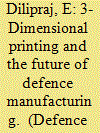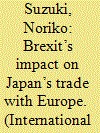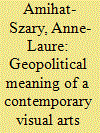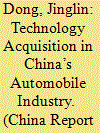|
|
|
Sort Order |
|
|
|
Items / Page
|
|
|
|
|
|
|
| Srl | Item |
| 1 |
ID:
130567


|
|
|
| 2 |
ID:
171939


|
|
|
|
|
| Summary/Abstract |
International monetary organisations argue the ‘developing countries’ should foster linkages to the world economy as a means to overcome backwardness. In this article we refute the narrative that Mexico has experienced industrial upgrading. Rather, industrial growth in Mexico over the last 40 years has been shaped by neoliberal economic policies which have turned the Mexican economy into an export-led manufacturing platform designed to supply the North American market, sustained by a precarious labour market. As a result, Mexico occupies the most labour-intensive and low value-added segments of regional production chains. To make this argument, we perform an in-depth analysis of the Mexican automotive industry, demonstrating that instead of being an engine for domestic industrial development, the auto industry has become a dominant economic sector through productive hyper-specialisation concentrated in the northern Mexican border states, a reliance on transnational capital, particularly from the United States, a disconnect with domestic markets, and the super-exploitation of labour.
|
|
|
|
|
|
|
|
|
|
|
|
|
|
|
|
| 3 |
ID:
178031


|
|
|
|
|
| Summary/Abstract |
In the context of globalization, the Japanese government emphasizes the importance of reinforcing the free trade system. Due to European Union’s (EU) reluctance, the free trade agreement (FTA) negotiations between Japan and the EU took 4 years to conclude. However, Brexit prompted the conclusion of Economic Partnership Agreement (EPA) with the EU as to maintain the economic interests of both sides after the British exit from the EU. The UK wants to maintain economic relations with Japan and to become a ‘Global Britain’ in the post-Brexit era. This article analyses both Japan–EU and Japan–UK FTAs. The core of the article looks at the impact of Brexit on Japan’s access to the European single market through a review of Japanese sectors and large corporations, particularly the automobile industry.
|
|
|
|
|
|
|
|
|
|
|
|
|
|
|
|
| 4 |
ID:
151165


|
|
|
|
|
| Summary/Abstract |
This article addresses the effect of foreign direct investment (FDI) flows from China to Korea, particularly in the case of the automobile industry. Despite the various positive effects that FDI brings to the growth of the automobile industry, concerns and doubts have been cast upon China’s overseas investment in Korea’s automobile industry, as FDI may involve the transfer of technology, and thereby, China may soon catch up with Korea technologically. The Shanghai Automotive Industrial Corporation’s (SAIC) acquisition of one of the automobile producers of Korea, Ssangyong Motor Corporation, and the consequent technology transfer or leakage have become a controversial national issue in Korea. This article draws the policy implications from the case of the former corporation’s acquisition of the latter in light of the economic development and industrialisation of developing countries in general.
|
|
|
|
|
|
|
|
|
|
|
|
|
|
|
|
| 5 |
ID:
121232


|
|
|
|
|
| Publication |
2012.
|
| Summary/Abstract |
WHY SEEK A VISUAL UNDERSTANDING OF BORDERS?
Their common border can be seen as a synecdoche of the complex relations
between Canada and the United States: not only is it the longest border in the
world (at 8,891 kilometres-5,061 kilometres on land and 3,830 kilometres
at sea), but it also represents a line where strong and soft politics and
geopolitics converge. One can say that the border not only divides the two
states but reflects their relations. Until recently, the border was considered
one of the most "benign" the world-an exceptional label, considering the border's length.1
For over two centuries, political divisions between the two
countries, inherited in part from a colonial divide in the east but also from the
outcome of frontier competition in the west, did not represent an obstacle to
everyday life in the border regions. In fact, various economic activities have
benefitted from houses built on the line in order to evade taxation, to the
more complex industrial systems, such as that of the automobile industry
in the Great Lakes region. These activities have led to the consolidation of a
number of cross-border regions, enhanced by NAFTA, which are witnesses
to both the vitality and variety of interactions along the line.2
|
|
|
|
|
|
|
|
|
|
|
|
|
|
|
|
| 6 |
ID:
099576


|
|
|
|
|
| Publication |
2010.
|
| Summary/Abstract |
This, the second, part of the article examines road, water, air, and pipeline transportation. China's focus on giving priority to the development of transportation industries over the past 30 years of reforms has made it the world's leader in container manufacture and containerized freight shipments and placed it second, after the U.S., in the length of high-speed highways and the number of air passengers. Development of all the transportation modes is financed predominantly from the government budget and depends on wise application of free-market mechanisms. The breakthroughs achieved by China's transportation industries are an illustration of its flexible crisis management strategy.
|
|
|
|
|
|
|
|
|
|
|
|
|
|
|
|
| 7 |
ID:
174701


|
|
|
|
|
| Summary/Abstract |
China’s automobile industry has succeeded remarkably since the 1980s. The Chinese government welcomed foreign automobile companies to form joint ventures. The local automobile companies began to enter the market in the late 1990s. To compete with the foreign rivals, they needed to acquire advanced technologies. Meanwhile, technology transfer through foreign direct investment (FDI) inflows was not so successful. Some of the local automobile producers developed their technologies through FDI outflows. The large local automobile producers have paid much attention to their own research and development (R&D) activities. China has tried hard to build its human capital. Acquiring intellectual property rights from foreign manufacturers has been another way for the local producers to acquire advanced technologies. They have also tried to establish partnerships with the local technology groups. The ways in which the local automobile companies acquired advanced technologies may provide meaningful policy implications for the other technology-intensive industries and developing countries trying to develop the automobile industry.
|
|
|
|
|
|
|
|
|
|
|
|
|
|
|
|
| 8 |
ID:
091184


|
|
|
|
|
| Publication |
2009.
|
| Summary/Abstract |
This will be Toyota's first operationg loss since 1938, which was just its second year of business. In 1950, amid the post-World War II turmoil, the company made a pretax loss and laid off some its employees, and Toyota Kiichiro resigned as president to take responsibility for the resulting labor dispute.
|
|
|
|
|
|
|
|
|
|
|
|
|
|
|
|
|
|
|
|
|